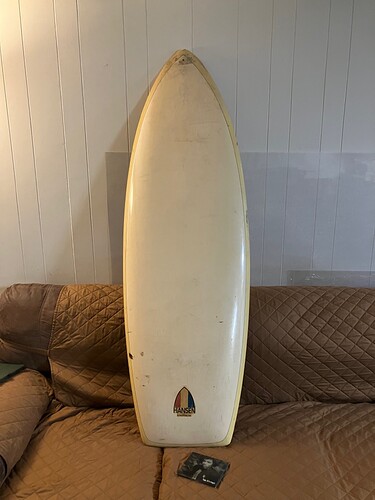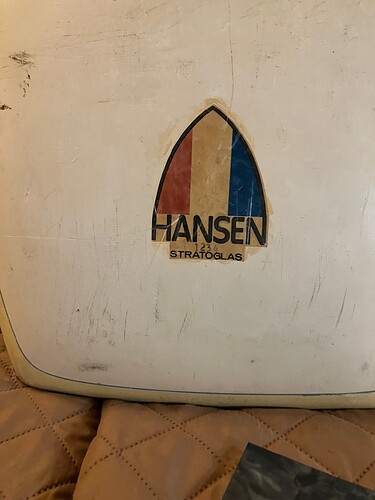Paipo purists don’t like the corky feeling of a buoyant foam and glass board. The wood Paipo standard seems to about 0.5” thick and 48” +/- long.
One big advantage of the all-wood Paipo is easy duck diving.
(Personally I like buoyancy and arm paddling.)
But swim fins can be a welcome break on the (paddle) way back out, without losing momentum.
@Huck
On the way out you can kick while holding the board with hands and forearms (assuming you have no-slip grip), a nice break from arm paddling (conserving energy). I used to do pool kick laps with a Morey Boogie that way.
The 5’6” channel fish I designed (jrandy is building one) is my paddle-in prone-riding alternative — with a stand up option should my aging reflexes cooperate.
Ohhhkaaay, a few things:
1- you’re overthinking this. Your takeoff and the rest of the wave are where the wave is pretty much vertical . That’s where paipos and kneeboards live . You don’t have a helluva lot of planing area, you’ll stall out on the flat. Stay in the pocket.
2- to paraphrase the Borg, ‘Buoyancy is futile’. Useless on the wave, punching through on the way out and yeah, float isn’t helping you there either.
3- I’m seeing a lot of ‘ooo, I don’t use swim fins’. Next, it’ll be how wonderful it is with no fins and webbed gloves. No, it isn’t. I used to get people coming in to the shop asking for webbed gloves and I’d ask them what kind of fins they used. On account of they didn’t come in walking on their hands, fins give you way more thrust and can do it all day. If you’re not a paraplegic, your legs are the strongest muscles you have with far, far more stamina than your arms/shoulders. With a paipo or kneeboard you’re using your legs and fins all the time, arms come into it for a little extra taking off or for a couple of minutes variety in the lineup.
Look, if you want to prone ride a longboard, by all means. You can take the swell way way before it’s starting to break. You don’t need fins. Hell, you really don’t need a wave.
On the other hand, if you want to push the limits,
doc…
I respect your input and knowledge doc. But my personal experience differs. Legs are Homo sapiens power house on land, that power isn’t as effective in water. To extend your analogy about gloves, humans don’t have webbed feet for walking and running. Gastrocs are most effective for extending toes (superior control over heels, why most prefer frontside surfing).
Tried webbed gloves “once.” Hell on your shoulder joints, especially rotator cuffs. Never again! Later read they place undue strain/stress on shoulder joints. My shoulders already have too much battle damage from high school football, post-grad rugby, and street carving in my mid-60s.
My perspective differs about fins. They are great for endurance/distance. However, IMO not so much for instantaneous acceleration. They certainly augment speed.
Jay Reale (retired pro-bodyboarder) is the one who told me, in person, to paddle with your single free arm while kicking. Later in a pool, I tested for myself the difference with and without the free arm. The instaneous acceleration with one arm was substantially greater.
For me, the instantaneous acceleration of the 2-arm crawl stroke is vastly superior to that of fins — much farther, much faster in significantly less time. I can do many more laps in much less time using arms only than I can with fins only and a barely buoyant swimming kick board. Difficult to crawl paddle on a barely buoyant board…
Finally, often, corking back up on my 7’6” Morey-Doyle surfboard, after the pull-down, gave me enough instant acceleration for “no-paddle” late take-offs. Without a fair amount buoyancy, there is no significant amount of corking back up. Corking back up on a bodyboard breaks starting inertia and turbo-charges the effectiveness of the initial fin kicking. One-arm paddle is the instantaneous accelerator — even more power with 2 arms.
As I’m sure you know, the take-off is about generating instantaneous planing speed and critical wave speed velocity (C) as soon as possible. Fins win hands down (![]() ) for long distance endurance. And low buoyancy boards are much easier to duck dive.
) for long distance endurance. And low buoyancy boards are much easier to duck dive.
(But I have successfully duck dived a 9’ longboard — it’s about physics and shifting buoyancy in your favor.)
Edit: BTW my early 70s 5’6” (hollow) Hansen Stratoglas twin had lots of bouyancy, paddled well with 2 arms, caught waves well, had skateboard-like responsiveness and made nice late, steep drops.
Oh my gawd. The Hansen Stratoglas, two foam skins over some foam pillars.
I once gave one lung cancer. They had this squirt gun plug/vent up in the nose, the hole was just the right size to fit a cigarette filter. And the foam pillars inside, well, they’d compress surprisingly well. So you’d suck air out of the board (compressing the deck worked too) and then hold your Marlboro to the hole, the cigarette coal would glow red and burn down.
You pushed on the deck, it’d blow a stream of smoke. Thump on the deck, it’d blow smoke rings.
Yeah, well, the’70s. Tobacco wasn’t the only thing we were smoking. Hollow boards, the hollow WAVEs and then a very few of those Hansens.
Anyhow, back to fins.
Of course, after years of working construction and commercial fishing, my shoulders are scrapple.
Let me draw a distinction between fins and ‘surf fins’. The latter have a rather pathetic blade area, about the same as your foot. Usually used with a flutter kick*, the thrust from them, well, not much. Toe protectors. Great ‘fins’ for, say, lifeguards, when they can run from the stand to the water wearing them. Great fins for somebody who doesn’t want to wear fins.
The design of them is typically a stiff blade and a soft foot pocket. This was a selling point for some of them. Like putting a turbocharged engine in a go kart with a frame made of bubble gum. You move your feet, the blades flap and it’s like something out of Shakespeare, ‘full of sound and of fury, signifying nothing’.
Then there’s fins like my weapon of choice, the UDT duck feet. Especially the late ones that benefitted from the genius of Dr. Greg Deets. Blade flexible, foot pocket not so much, serving as a solid base to transmit power. A relatively slow kick motors you right along, kick a bit faster and harder and you can punch through a wave or (if you’re not overburdened with buoyancy) push the nose down and go under it.
Blade area, at least 4 times the area of the foot alone. Catching waves, with a kneeboard or yes, even my old Newport Paipo Concave Vector, you could and I did do a next to no-paddle takeoff, push the board down with both hands and as it came back up, a frog kick and there you had it. Oh, and hang onto the rail, use a little edge and go like hell.
Anywho. I think the reason everyone talks that way about fins is they’re not wearing real fins, they’re wearing ‘surf fins’. If you commit to using something with some blade area, waay different story.
One of these days, I want to try my snorkeling/freediving fins surfing.
*A bit of trivia. The flutter kick came into competitive swimming when the Hawaiians like Duke Paoa Kahanamoku got into the competitions. The kick didn’t add any meaningful thrust, what it did was bring the legs and upper body up parallel with the surface, making for much less drag and much more speed
doc…kicking and screaming.
Owned and rode a 5’6” Hansen Stratoglas twin that I bought on sale at Locked In Surf Shop (Houston) in late ‘72 or early ‘73. (A very different ride from my used 9’8” longboard and my ‘68, 7’6” semi-gun.). Bought a 6’2” WAVE from a buddy who stopped surfing after high school. Never rode the WAVE before it vaporized in a house fire — nose of the Hansen got toasted a little. Lost several old classics in that fire. Fortunately the 9’8” Bing Nuuhiwa Noserider survived unscathed under a bed.
As a young boy I loved the traditional diver fins. But as I grew and my feet widened the stiff pockets dug into my instep and top of my foot. After 45 min they were very painful. I bought a couple of new pairs of the classic old diving Rocket Fins with the idea of modifying length and the hope that neoprene socks would make wearing them bearable a few years ago (still in the box). But I like my Da Fins well enough with fin socks.
I always hated the kick in the Australian Crawl. Since I surfed, and kicking wasn’t part of the paddle out, I started doing pool laps (Australian Crawl) with arms only, no kicking. Been doing pool laps that way ever since. Before they closed the local indoor pool, I did an equal number of kick only laps with Da Fins and a swimming kickboard, later an old Morey Boogie (Vega model).
My “no paddle” surfboard late take-offs never used a kick of any kind, just a spin-roll into 45-degree pull down: followed by the corking forward launch. The first no-paddle late take-off caught me by surprise — didn’t have time to paddle with both arms before the instant slide began…
Oh dearie me, the Hollow WAVEs. They were going to be the New Great Thing and in truth there was merit to the construction method but…
I think they rushed it. The shapes were limited by the process, they were only available in a small range of dark and disappointing colors and of course they didn’t really have the bugs out of them, durability wise. Wasn’t there a 5’-something or 6’0" that was just short and ugly like midget wrestling?
Me, I liked to roll off my board on a warmish day, lie on my back with arms folded and kick along slowly like one of these guys-
doc…
Back in 2019 I had smashed one of my fingers really bad, and I had to stay out of the water a while. At the same time a place I surf closed the walking path and only the goat trails were open. I decided to make some Paipos (belly boards) to be easier to get the down the cliffs and surf. Growing up we all started on wood paipos and either worked our way up to a real real surfboard, or quit. I tried to make something that was once very popular, the Makapu’u shape, but modified, and then something friend said he used to like growing up, a very simple small rounded nose board. They were less than an inch thick and barely float me. If I sit on them my head is just above the water. I found that I had a hard time controlling the Makapu’u style board, but I really had fun with the little one. I had some great little barrels with that one. I made a third on that was about and inch and a half thick, but it wasn’t as good as the simple one. They are all finless, and about 3 feet long, slight rocker and concave bottoms.
A couple of things. Small gutless waves are small gutless waves. It is likely the case that your board isn’t suited to them. My paipo exponentially performs better as power increases. This is a likely quiver issue. Water time and experimenting will help work this out as well as to paddle or kick. My preference is to kick but that is because my shoulder tendons etc are worn out. A paddle/kick combo is likely the most effective though Doc fin recommendation is fine, if you have conditioned legs. All this can take a while, one day it all clicks.
At 3-4” thick, 24” wide and 42” long; Huck’s bellyboard appears to have significant volume. As a result it is likely to be substantially more buoyant than typical bodyboards, Paipos, and bellyboards.
IMO precise take-off technique will be critical to getting max performance from his board.
Also a couple of things, following up Bob. And, by the way, he knows paipos like few others. pay close attention to what he says.
Awright, first of all-
Perversely, of the prone forms, what IS best suited for small, gutless waves? A surf mat, not inflated to the max. It will flex a lot, easily, and conform to the waterflow better than anything else, lowering drag and eking out what limited speed you can get. Buoyancy doesn’t matter.
Leg conditioning… you want really strong calf muscles and good range of ankle motion to get the power out of the fins and to prevent cramping.
You could take up ballet, going around the stage on your toes is going to work the calves REALLY well, plus you meet a lot of really in-shape women in tights and very short skirts.
Unfortunately, I resemble nothing so much as a mountain gorilla or bonobo so that approach doesn’t work for me. What I did instead was put toe clips on my bike pedals and raise the seat a smidge. This lets you work the whole range of leg motion, getting that last little bit of power by consciously pushing/extending with your ankles.
hope that’s of use
doc…
Never expected an absolute statement like this from you doc.
Archimedes might view the amount of required mat displacement volume differently…
Umm, buoyancy only matters when you’re floating. And moving slowly or not at all. Perhaps I might have said that buoyancy is irrelevant.
There’s a lot of misconceptions in surfing. Let’s take one: displacement hulls. A lot of boards with somewhat convex bottoms get called that…but they’re not.
A displacement hull …displaces water as it goes through it, floating. A surf craft isn’t doing that, it’s planing on top of the water surface. Floatation is irrelevant.
The rule of thumb is that you take the square root of the waterline length in feet, multiply that by 4/3. This gives you a number which you express in statute miles per hour, that’s the maximum displacement speed*. The boat or ship is happily tooling along pretty much level and yes, buoyancy matters.
Above that 4/3, the hull is climbing its bow wave, angling up, lot of drag so it needs a lot of power, until you get to 2 times the square root, etc, that’s planing speed. Drag falls off and off you go. The thing isn’t floating, instead it’s generating dynamic lift from the hull form, with sufficient power to deal with whatever drag said hull form makes**.
Consider a water ski. Barely floats itself but with sufficient power and speed you can get up on top of the water and there ya go. Slow down, it stalls.
There’s other calculations you can do, how much power it takes to drive a planing hull at a given speed, how much more or less is needed if you add or subtract weight. But that’s outside the scope of this…
doc…
*4/3 x(sqrt (wl length in feet)) expressed in statute miles per hour is a good rule of thumb, though yes, there are some that are faster, notably high end racing sailboats. Not relevant to this… besides, you don’t want to know the tank testing and modelling that goes into refining those.
** Drag of a planing hull gets interesting. There are some hulls…and boats… that won’t plane, notably those with what we would call extreme tail rocker. The bow rises, the stern squats, add all the power you want, it ain’t going faster.
Consider, now, a gutless wave. Precious little power. To plane using that for your power, well, you need something that will conform to the water surface you’re going across. Like, say, a surf mat that’s a little floppy…
Displacement as Archimedes referred to it is required for the mat to float a given mass/weight (aka buoyancy).
“Archimedes’ principle states that the buoyant force on an object submerged in a fluid is equal to the weight of the fluid ‘displaced’ by the object.”
The amount of bouyancy determines how much of the Surfcraft is below the surface when stationary (affecting initial/start up drag — plowing). A limp/flacid air mat cannot achieve planing speed in the relative sphere achieved by surf mats in small or large waves. (Too limp, and the mat increases drag). In addition to stiffness, the air also provides buoyancy/low-mass volume. Without sufficient buoyancy and stiffness the amount of work/energy required to overcome inertia and drag to achieve planing speed is immense — far more than can be achieved with arms or legs.
EDIT: Stiffness also affects plowing (drag).
Ah, interesting day. Power went out night before last and everything but the desktop machine came back on fine. It’s either fried (bad) or it’s just the AC adapter gave up the ghost. Fun.
In any event-
I’m not suggesting that a mat be deflated nearly completely, I’m thinking , oh, as an analogy let’s say a fresh French loaf versus a stale one. Soft enough that it’s not rigid, so it will conform to the surface as it planes.
Again, when catching a wave, it’s not buoyancy or paddling, unless you’re talking SUPs, who are on the things when they’re ripples. Though those are more boats than anything else.
If it was, paipos, bodyboards and short, thin surfboards would never catch a wave. The human body can generate what, up to 1/4 horsepower, not enough to
Rather, it’s gravity. The smaller the craft, the less planing area. The less planing area, the more speed it takes to generate lift. The more speed you need, the steeper the wave face has to be. And the later you have to take off and the closer to the pocket you need to stay.
Consider no-paddle takeoffs. How they work and where they work. The buoyancy acts like a spring, push the board down against resistance, it wants to pop back up, f=kx. But that’s a temporary thing, where catching the wave only needs that little bit of power.
Yeah, I was, still am, that weird SOB that watches things and thinks about the physics.
doc…
If only it was that simple. But it is not.
I too am a fan of physics. I use it frequently.
A proper discussion would require equations, derivation and lengthy/detailed explanations. However, I am not going to hijack Huck’s thread with that.
I will mention just a few critical factors that have not been addressed.
There are two velocities critical to surfing: take-off and planing. (I will not get into planing speed/velocity.)
Nonetheless, both are affected by surface area, force, acceleration, mass, inertia, static drag and dynamic drag.
“To overcome inertia, an object requires energy input in the form of force. Inertia is the tendency of an object to resist changes in its motion, whether at rest or in motion. The amount of force (and thus energy) needed is directly related to the object’s mass and the desired change in motion (acceleration).A greater mass means more inertia, requiring more force to change its state of motion.”
Force is affected by mass and acceleration.
F = ma
Initial Force required is also affected by static drag.
Initial F required = ma + static drag
To achieve critical velocity from a motionless state an object must Accelerate.
Acceleration is affected by mass (load), force and drag.
a = F/m – dynamic Drag
Greater load (mass) alone reduces Acceleration.
Greater load requires greater Force to Accelerate.
Drag is affected by submerged Surface Area.
Submerged Surface Area is affected by Total Submerged Volume.
Total Submerged Volume is affected by Load (mass) and “Buoyancy.”
Higher Load (mass) = greater Submerged Volume
Greater Submerged Volume = greater submerged Surface Area.
Greater submerged Surface Area = greater Drag.
Higher load = slower Acceleration
Greater Surface Area = greater Drag = slower Acceleration
Slower Acceleration = greater time/distance to critical velocity
Surface Area to Volume Ratio tends to be greater for smaller objects (volumes).
(Math Ellipsis)…
And this is just the tip of the iceberg.
The following is an excerpt from some work/calculations I did several years ago about wave and surfing speeds/velocities.
“To begin sliding down a wave face, surfer shoreward velocity must first equal wave speed (C), net velocity = 0. Essentially, a surfer’s (actual) Vo at the top of a wave for take-offs and/or re-entries must = C. (However, Relative Vo = 0; surfer shoreward speed minus wave speed equals zero).”
The complete work/discussion can be found at this link.
Accept. Reject. It does not affect me.
Should have added this fairly simple, conceptual figure to the previous post also. Another of the many factors that affects (or is affected by) the parameters I last mentioned — wave face slope.
Wave form (spilling vs. plunging) changes wave speed, drop acceleration and time to critical take-off velocity and maximum drop velocity.
From:
That formula looks like the beginning of that “el rollo” in the tube that I envisioned .
Since i mostly windsurf slalom i know what is planning, it’s graal ! Board volume is choose to carry sailor and enough sail up to planning. From there low volume feel better and easier to ride.
Any updates Huck?
Inquiring minds want to know.





